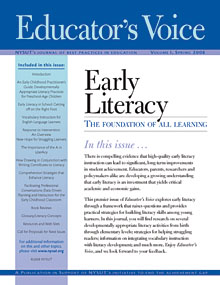Educator's Voice is a series of journals of best practices in education produced by NYSUT. Educator's Voice provides research-based, field-tested strategies that have been used by experienced educators to help schools close achievement gaps and ensure all students have a solid academic foundation.

NYSUT launches academic journal
John Strachan - New York Teacher - May 2008
In classrooms across the state, NYSUT educators are quietly developing successful, research-based strategies to enhance student literacy skills, particularly in the critical early years. Combine that with an increasing focus on early literacy at the state level and it's clear that some key elements for closing the achievement gap are falling into place.
"What we needed was a forum for educators to share those best practices with others," NYSUT Vice President Maria Neira said, explaining the creation of Educator's Voice, the statewide union's new journal of best practices in education. "We wanted to turn the spotlight on successful classroom practices and the reasons why they are successful."
Released at NYSUT's convention last month and accessible online at NYSUT website, the first volume of the journal is devoted to early literacy as "the foundation of all learning." Subsequent volumes will deal with literacy in grades 5-8 next year and grades 7-12 in 2010.
The journal is part of a vast campaign by NYSUT to end the achievement gap that separates students in low-need school districts from those in urban and poor rural districts, many of them children of color.
"Research has shown that early literacy is critical to ensuring high levels of achievement for students not only during their academic career, but for the rest of their lives," said NYSUT President Dick Iannuzzi, who spent 34 years teaching at the elementary level.
Printed on recycled materials and illustrated exclusively with photos of NYSUT members and their students, the premier issue of Educator's Voice contains eight research-based articles on early literacy, from pre-K through grade 4.
All were written by NYSUT members: elementary teachers, literacy coaches, representatives of higher ed and some who work with teacher centers.
The 70-page journal also contains reviews of three books on early literacy, a glossary of terms associated with the topic and a list of additional resources — including a number of useful Web sites — for early-childhood educators and early-literacy providers.
One who appreciated the journal was Ben Frisbie of the Owego-Apalachin Teachers Association, a member of the NYSUT Board of Directors. "I felt very validated when I reviewed the Promoting Comprehension Strategies section. As a longtime social studies teacher, I used many of those strategies. It is so powerful to have these 15 listed in one place."
New York state's 2007 Teacher of the Year, Marguerite Izzo, read the journal "cover to cover" in one sitting "because it is written in such a teacher-friendly way, by professionals who use the strategies every day."
Izzo, a member of Malverne TA, said she and fellow Long Islander Steve Bongiovi — a member of United Teachers of Seaford who preceded her as Teacher of the Year in 2006 — are using the journal in graduate literacy courses they teach.
"Our students told both of us that these were the most valuable articles they read," Izzo said.
Teachers bring change
"I believe strongly in teachers as agents of change," said journal author Kristin Dale, a first-grade teacher and a member of the Dover-Wingdale TA in Dutchess County. "It's how we can raise the standards of consistency and success for all students."
In her part-time work as an instructor for NYSUT's Education & Learning Trust, the union's professional development unit, Dale finds teachers often unaware of how effective they are and how much knowledge they have to share with fellow classroom professionals.
"It's important to promote that," Dale said, explaining why she took time to write an article on strategies to help primary teachers meet a key challenge of No Child Left Behind — that every child read by the end of third grade.
Authors Joan Davidson and Patricia Barbanell have enjoyed similar careers. Both are retired K-12 visual arts teachers who have headed the New York State Art Teachers Association and serve on NYSUT's Committee on the Visual and Performing Arts. In separate journal articles, both wrote on the synergy between visual images and the written word and how this can be leveraged to the benefit of early learners.
Katie Kurjakovic, an ESL teacher in Queens and a member of NYSUT's Committee on English Language Learners, wrote about how she adapted research-based strategies for teaching vocabulary to ELLs.
"I wanted to share a non-traditional but infinitely more effective method for vocabulary instruction," said Kurjakovic, a member of the United Federation of Teachers, NYSUT's affiliate in New York City schools. "When you find something that works better, you want to share it."
The authors, Neira said, represent a small sampling of the NYSUT professionals who have effective, research-based strategies to share with others across the state.
"'Best practice' is being defined in our classrooms every day," Neira said. "And promoting best practice is at the heart of everything we do."
- John Strachan